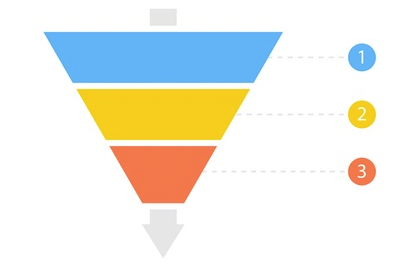I’ve never been a pure salesman, but I am aware of one of the most basic sales concepts: the idea of the sales funnel. According to this concept, prospects begin their purchasing journey at the top of the funnel, which is the widest part, when they become aware of what you’re selling.
In the next stage, prospects move down into the middle of the funnel as they consider whether they might want to buy your stuff. These customers know they have a need for something like what you’re selling and are actively shopping with the intent to buy.
The bottom of the sales funnel is the narrowest part. This is where prospects will decide whether they’re gonna buy your stuff or not — and the sale is either closed … or lost.
Content strategy can play a big role in leading prospects through your sales funnel from awareness to consideration and finally a purchase decision. The key is knowing what types of content to serve up at each stage of the funnel.
Top of the Funnel: Cast a Wide Net
Your goal as a marketer should be to get as many good prospects into the top of your sales funnel as you can. In other words, you want to cast as wide a net as possible. To do this, you should create educational content that’s informative and helps position you as a subject matter expert, or SME.
Blogs and articles are ideal content assets for the top of the sales funnel. Importantly, your content at this stage should be value-added, not sales-focused. Remember, your goal is to push prospects down into the middle of the funnel. If you hit them too hard with a sales message at this stage, you will probably drive them away.
For example, you can write blogs and articles about general industry topics and trends. In the financial services industry where I specialize, top-of-funnel topics include things like budgeting, tax planning, saving for retirement, managing debt and estate planning.
Middle of the Funnel: Start Shifting to Sales
Those who reach the middle of your sales funnel are now qualified prospects. They have engaged with your top-of-funnel content and you have gotten their attention, convincing them that you might have a solution to their problem.
In a B2B sale, prospects at this stage are usually gathering information from different providers and evaluating their options to help them make an informed buying decision. So it’s OK to shift your content from pure value-added to a little bit of sales and promotion. Specifically, you want to demonstrate how your solution can help solve their problem or meet their need.
Webinars, whitepapers and e-books are great content assets for the middle of the sales funnel. Many of these prospects are engaged enough with your brand that they’re willing to devote 30 minutes or an hour to hearing more about your solution in a webinar, or reading an in-depth whitepaper or e-book.
But the content still can’t be too salesy. For example, a webinar shouldn’t be an hour-long commercial for your business. Instead, focus on how your solution has helped one of your clients solve a specific problem or meet specific objectives. One of my clients, Consero Global, does webinars like this every quarter or so, which I then turn into a blog.
Bottom of the Funnel: Close the Sale
Prospects who reach the bottom of your sales funnel are one step away from becoming clients. So at this stage, it’s time to make a final push with highly personalized and detailed content designed to close the sale.
Case studies and testimonials are among the best content assets to accomplish this. These allow you to showcase the unique features and benefits of your solution, or your unique selling proposition (USP). Demonstrating how your solution helped similar clients solve problems can give prospects a greater sense of confidence in hiring you to solve theirs.
I have written several case studies like this for Nearview Media, a digital media consulting firm. Founding Partner Eric Shanfelt told me these case studies have been instrumental in showing potential clients the results of working with him. “They have helped convert companies that were just looking into actual paying customers,” he said.
Boost Your Content Marketing ROI
Planning your content strategy around your sales funnel is the best way to make sure you target the right kinds of content to prospects based on where they are in the sales cycle. This will help ensure that you get the best return on your content marketing investment.

